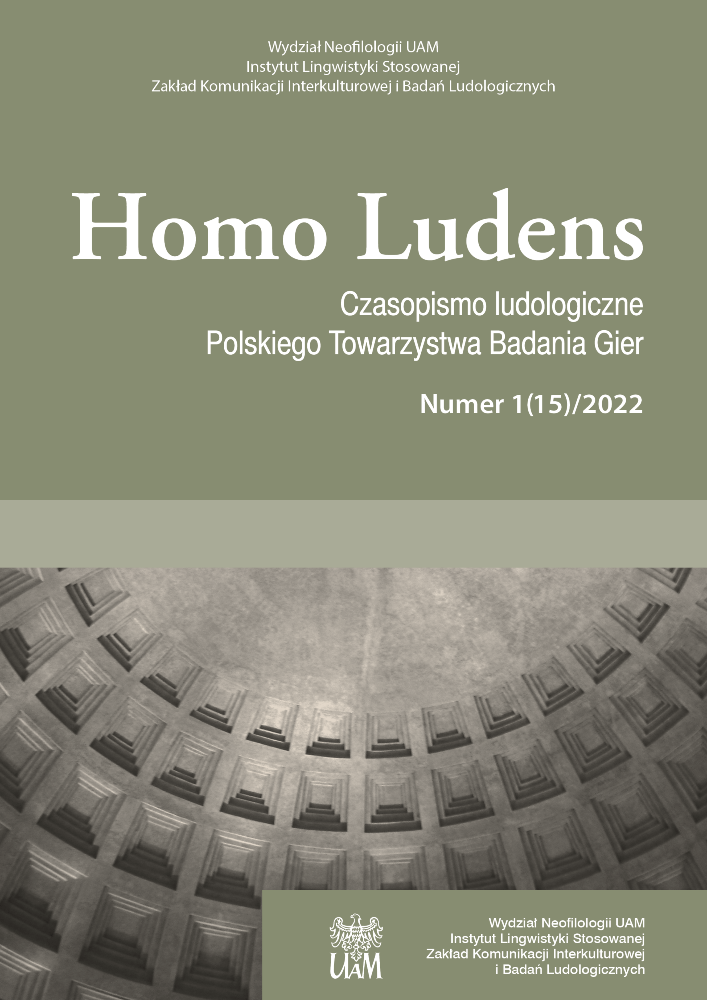Abstract
The article deals with the problem of transferring board games used in language education in classroom to distance learning. In the first part, we try to introduce the reader to the place of games and play in education, then we move on to the use of games specifically in teaching foreign languages. In the last part, we discuss six tools that teachers can use to create communication board games and help students master selected lexical or grammatical structures.
References
Becker, K. (2021). What’s the difference between gamification, serious games, educational games, and game-based learning? Academia Letters, Agnieszka Kruszyńska | Tworzenie interaktywnych gier planszowych w edukacji językowej 111 Article 209. Online: <https://www.academia.edu/45044609/What_s_the_difference_between_gamification_serious_games_educational_games_and_game_based_learning>. Data dostępu: 20 grudnia 2021. DOI: https://doi.org/10.20935/AL209
Bello Estévez, P. (1990). Didáctica de las lenguas segundas. Estrategias y recursos prácticos. Madryt: Santillana.
Chamorro Guerrero, M. D., Prat Fons, N. (1994). La aplicación de los juegos a la enseñanza de español como lengua extranjera. W: M. Peydró, G. Moraga (red.), Actas del Segundo Congreso Nacional de ASELE. Español para extranjeros: Didáctica e investigación (s. 235–245). Malaga: ASELE.
Comenio, J. A. (2000), Didáctica Magna. México: Porrúa.
Coste, D., North B., Sheils, J., Trim, J. (2003). Europejski System Opisu Kształcenia Językowego: uczenie się, nauczanie, ocenianie (tłum. W. Martyniuk). Warszawa: Wydawnictwa Centralnego Ośrodka Doskonalenia Nauczycieli.
Deterding, S. (2011). Situated motivational affordances of game elements: A conceptual model. Online: <http://gamification-research.org/wp-content/uploads/2011/04/09-Deterding.pdf>. Data dostępu: 14 grudnia 2021.
Dewey, J. (1997). Democracia y Educación. Una introducción a la filosofía de la educación (tłum. L. Luzuriaga). Madrid: Morata. Fernández, S. (2008). Crear y recrearse con la lengua en el aprendizaje de un idioma, marcoELE (nr 8), 23–39. Online: <https://marcoele.com/descargas/expolingua1994_fernandez.pdf>. Data dostępu: 17 grudnia 2021.
Hadfield, J. (1990). Intermediate communication games: A collection of games and activities for low to mid-intermediate students of English. Quarry Bay: Thomas Nelson.
Huizinga, J. (1985). Homo ludens. Zabawa jako źródło kultury (tłum. M. Kurecka, W. Wirpsza). Warszawa: Czytelnik.
Jodłowiec, M., Niżegorodcew, A. (2016). Nauczanie języków obcych w erze postmetodycznej: Główne założenia i kierunki, Półrocznik Językoznawczy Tertium. Tertium Linguistic Journal, 1(1&2), 284–293. DOI: https://doi.org/10.7592/Tertium2016.1.2.Jodlowiec
Kumaravadivelu, B. (2001). Toward a Postmethod Pedagogy. W: TESOL Quarterly (nr 35), 537–560. DOI: https://doi.org/10.2307/3588427
Pestalozzi, H. (1909). Jak Gertruda uczy swoje dzieci (tłum. W. Osterloff). Warszawa: Księgarnia Polska.
Piaget, J. (1961). La formación del símbolo en el niño. México: Fondo de Cultura Económica.
Platón. (1990). Leyes (tłum. F. Lisi). Madryt: Gredos.
Prensky, M. (2007). Digital Game-Based Learning. Saint Paul: Paragon House.
Rosen, E., Varela, R. (2009), Claves para comprender el Marco común europeo. Valencia: Enclave.
Róg, T. (2021). Nauczanie języków obcych. Teoria, badania, praktyka. Lublin: Werset.
Rousseau, J. J. (1985). Emilio. Madrid: Edaf.
Siek-Piskozub, T. (1994). Gry i zabawy w nauczaniu języków obcych. Warszawa: Wydawnictwa Szkolne i Pedagogiczne.
Siek-Piskozub, T. (2001). Uczyć się bawiąc. Strategia ludyczna na lekcji języka obcego. Warszawa: PWN.
Smoleń, M., (2015). Gamification as creation of a social system. W: J. Kopeć, K. Pacewicz (red.), Gamification. Critical approaches (s. 56–68). Warszawa: The Faculty of “Artes Liberales”.
Tkaczyk, P. (2011). Grywalizacja. Jak zastosować mechanizmy gier w działaniach marketingowych. Gliwice: Helion.
Vygotsky, L. S. (1982). El desarrollo de los procesos superiores. Barcelona: Crítica.
Werbach, K., Hunter, D., (2012). For The Win. How Game Thinking Can Revolutionize Your Business. Pennsylvania: Wharton School Press.
Wilczyńska, A. (2013). Juego didáctico: una herramienta indispensable a la hora de enseñar la gramática española, Studia Iberystyczne, 12(1), 315–328, Kraków: Księgarnia Akademicka. DOI: https://doi.org/10.12797/SI.12.2013.12.17
Zichermann, G., Cunningham, C. (2011). Gamification by Design: Implementing Game Mechanics in Web and Mobile Apps. Sebastopol: O’Reilly Media.
Gamestructor: <https://www.gamestructor.com/>
Genially: <https://genial.ly/>
QuizWhizzer: <https://quizwhizzer.com/>
Learnhip: <https://learnhip.com/>
Google Slides: <https://www.google.com/slides/about/>
Flippity: <https://www.flippity.net/>
License
Copyright (c) 2023 Agnieszka Kruszyńska

This work is licensed under a Creative Commons Attribution-NonCommercial-NoDerivatives 4.0 International License.
Szczegółowe informacje dotyczące prawa autorskiego zawarte są w umowie podpisywanej między wydawcą a autorem.
